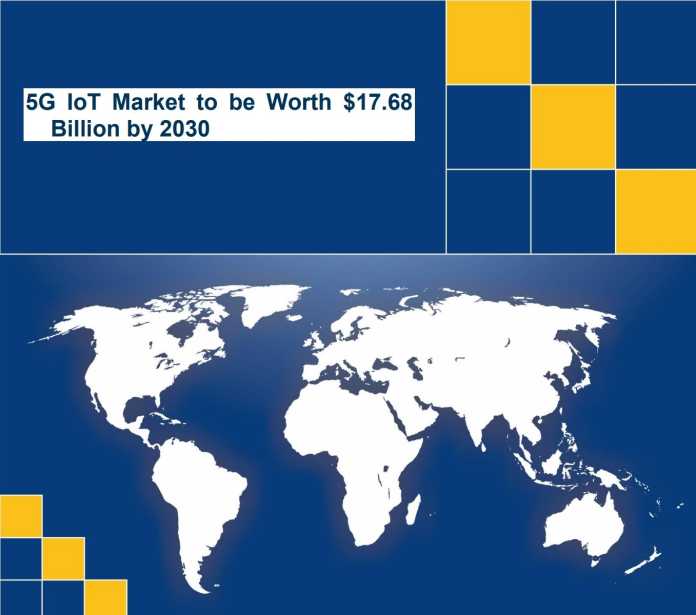According to a new market research report titled, 5G IoT Market by Component (Solutions, Connectivity Services), Architecture (5G NR Standalone, 5G NR Non-standalone), Application (Autonomous Vehicles, Security & Surveillance), End User, and Geography – Global Forecast to 2030, the global 5G IoT market is expected to grow at a compound annual growth rate of 47.6 percent through 2030 to reach $17.68 billion.
The Meticulous Research report calls 5G IoT a new generation of wireless technology to connect IoT devices at higher speeds. IoT devices collect data from other devices, while the 5G spectrum increases the frequencies to transfer data with a low latency rate to improve performance and reliability.
5G IoT is the latest trend for organizations supporting mobile and deskless employees ad IoT deployments, including fleet management, mobile devices, smart buildings, environmental monitoring and more. Among applications being used are in the automotive, transportation, agriculture, retail, and health care sectors, along with remote work from anywhere.
It also is used in smart factories, smart buildings, smart cities, smart utilities and security and surveillance. IoT devices can interact, communicate, and share information with other devices. These factors are contributing to the growth of the 5G IoT market.
With the consistent growth of the 5G IoT market across developing countries in Asia-Pacific, Latin America, the Middle East and Africa, opportunities for connected devices are rising. The growing significance of 5G IoT devices in smart city projects, increasing demand for low-latency IoT devices for Industrial 4.0, and increasing demand for digital wearable devices are the major factors driving the market growth.
In addition, the use of 5G IoT in self-driving vehicles and the high potential for 5G IoT in connected health care are expected to offer prominent opportunities for the growth of the market. High costs for 5G IoT network installation and security and data privacy concerns create challenges for market growth.
However, the global availability of 5G networks may hinder the growth of this market. The growing prevalence of network slicing, strengthening of edge computing applications, and rapid adoption of cloud computing across SMEs are new technology trends. In addition, the use of IoT for connected transportation and IoT-enabled security solutions are new market trends in the 5G IoT market during the forecast period.
The global 5G IoT market is segmented into solutions and connectivity services. The solutions segment is sub-segmented into platforms, hardware and business services. In 2023, the solutions segment is estimated to account for the largest share of the overall 5G IoT market. The increasing demand for cloud-based solutions is expected to drive the growth of this segment.
The report also segments the global 5G IoT market into autonomous vehicles, connected cars, industry 4.0, smart energy and utilities, smart farming, security and surveillance, smart health care, asset tracking, smart logistics and supply chains, smart consumer electronics, and other applications.
In 2023, the security and surveillance segment is estimated to account for the largest share of the 5G IoT market
The report also shows the global 5G IoT market is segmented into B2B end users (business-to-business) and B2C end users (business-to-consumer). In 2023, the B2B end-user segment is estimated to account for the largest share of the 5G IoT market. The growth of this segment is attributed to the increasing demand for connected services.
To download a free sample of the report, go to https://www.meticulousresearch.com/download-sample-report/cp_id=5436









